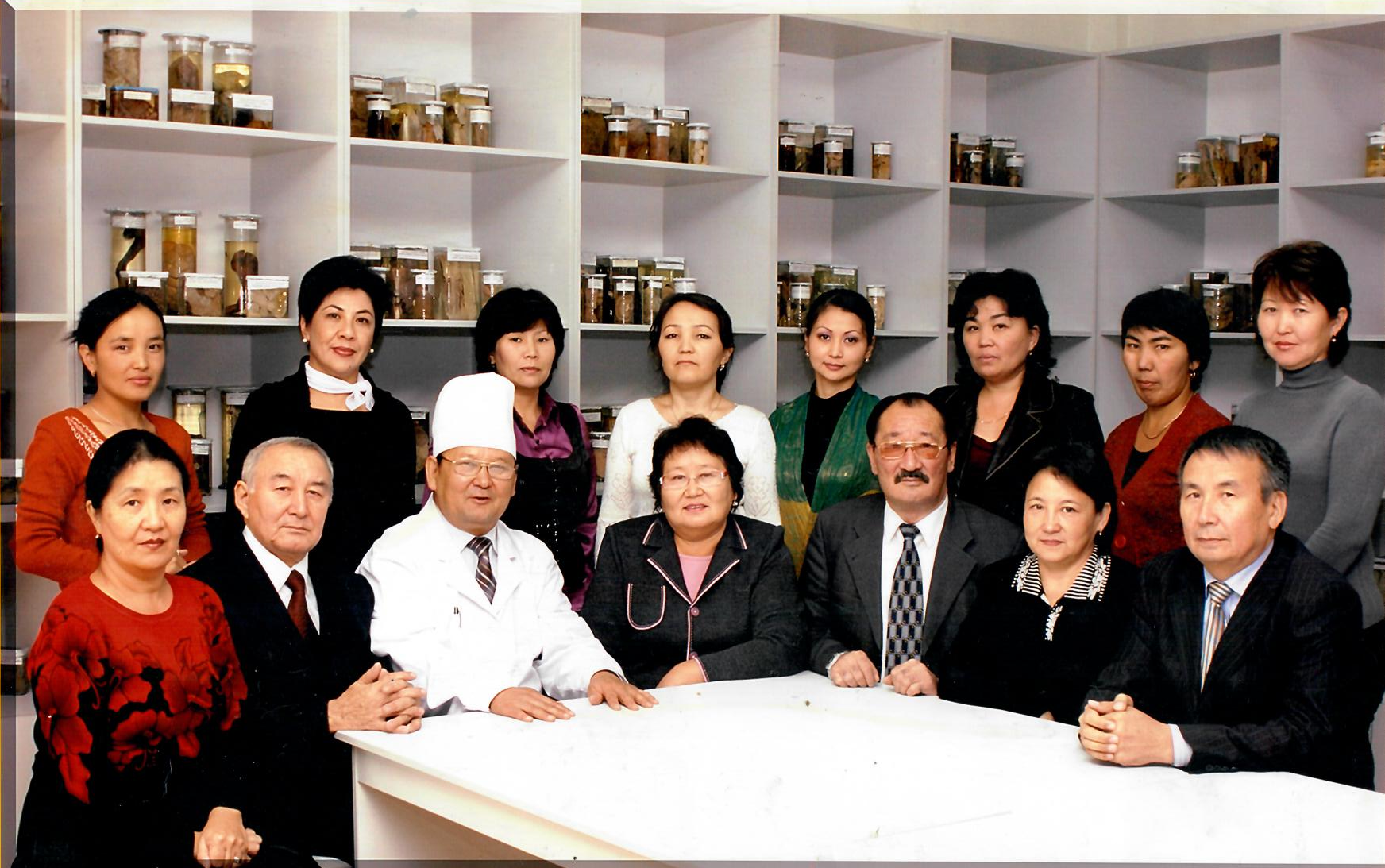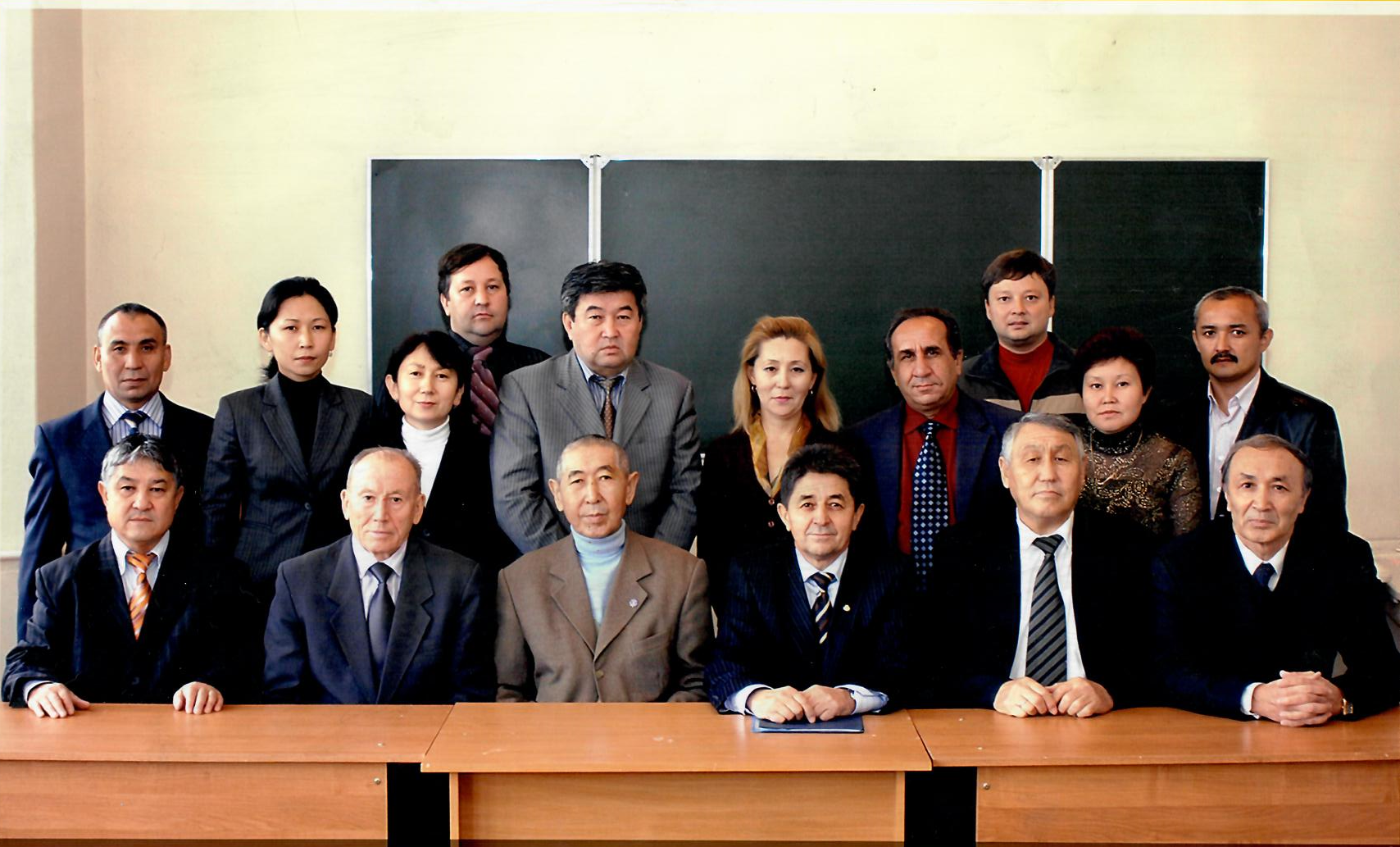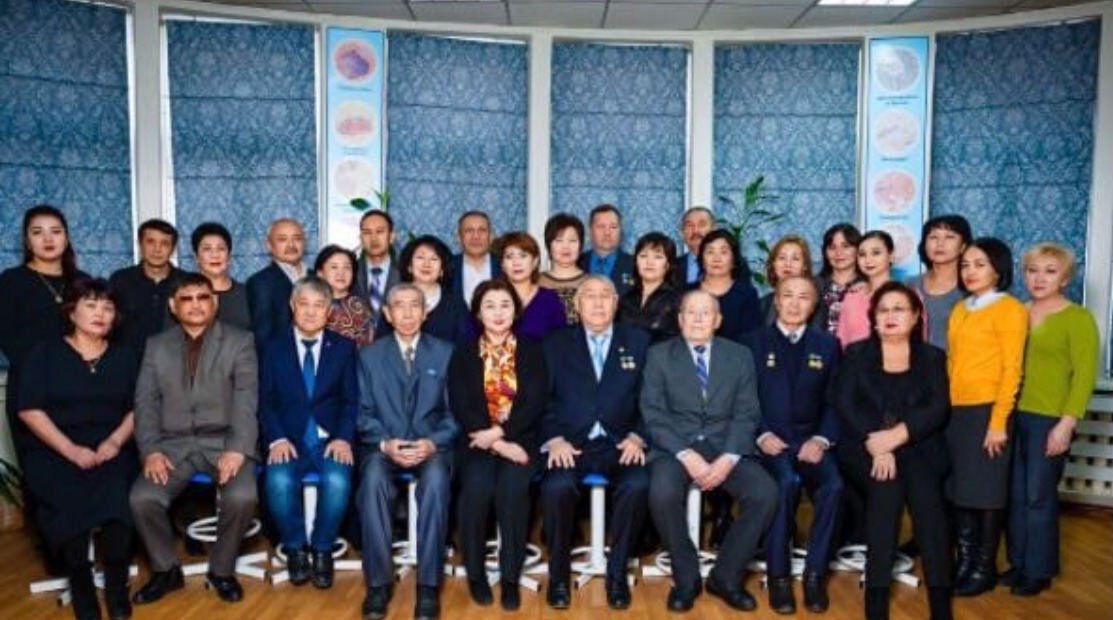The faculty of the Department of Biological Safety has high scientific and pedagogical potential. Today, the department employs 7 doctors of science, 17 candidates of science, 6 PhD, 7 masters of veterinary science.
The auxiliary staff of the department consists of 4 units, including a senior laboratory assistant, 3 laboratory assistants.
The department has 5 educational and scientific laboratories and one museum:
1. Museum of "Pathological Anatomy and Parasitology" named after Academician of the NAS RK, Professor Shabdarbayeva Gulnar Sabyrovna;
2. Educational and scientific laboratory "Serology" named after Academician of the NAS RK, Saiduldin Tleuberdi;
3. Educational and scientific laboratory "Molecular Virology and Antiviral Biotechnology" named after Professor Asanov Nygmetulla Gatauovich;
4. Educational and scientific laboratory "Antiparasitic biotechnology";
5. Educational and scientific laboratory "Microbiocenoses and construction of probiotics"
6. Educational and scientific laboratory "Veterinary safety".
The history of the department begins in 1929, when the Alma-Ata Zooveterinary Institute was opened and the departments of microbiology, epizootology, parasitology were created, and in 1931 the department of epizootology and organization of veterinary affairs was organized.
The Department of "Biological Safety" was formed in 2011 as a result of the merger of the departments of "Microbiology, Virology and Immunology", "Epizootology and Organization of Veterinary Affairs", "Pathology and Parasitology". The need for the formation of this department is due to the relevance of solving the problems of increasing threats from infectious diseases, the creation and development of innovative biotechnological processes and the development of veterinary drugs, obtaining environmentally friendly livestock products, preventing zoonotic diseases and protecting public health.
Department of Microbiology, Virology and Immunology. The first head of the microbiology department was Professor Ieronim Vasilyevich Saykovich, a famous microbiologist and the first rector of the institute.
From 1934 to 1961, the department was headed by Corresponding Member of the Academy of Sciences of the Kazakh SSR, Professor P.A. Bulanov. He studied the physiological properties of snake venom and on this basis developed methods for obtaining an antidote for snakes, which was approved by the State Control Institute of Veterinary Preparations (Moscow). Later, these works were continued, and the preparations were improved by his graduate student E.N. Nauryzbaev, who later became an associate professor of the department.
Professor P.A. Bulanov also developed a vaccine against brucellosis in cattle. The obtained attenuated strain (A6-1) for the prevention of brucellosis was tested under experimental conditions with positive results (P.A. Bulanov, B.A. Matvienko, E. Nauryzbayev and A.A. Myakushin). From 1961 to 1988, the department was headed by Doctor of Biological Sciences, Professor B.A. Matvienko. He became a pioneer in the field of using live vaccines against animal salmonellosis. For many years, vaccines were tested on farms in Kazakhstan on a significant number of animals. A live vaccine against salmonellosis of pigs was introduced into practice. In 1972, Professor B.A. Matvienko and Associate Professor O.Sh. Baiturina were awarded the State Prize of the Kazakh SSR for the development of specific means of preventing salmonellosis of pigs and sheep. From 1989 to 1996, the department was headed by Doctor of Biological Sciences, Professor B. T. Tolysbaev. Under his leadership, valuable industrial strains of urobacteria were obtained, which were deposited at the All-Russian Research Institute of Genetics and Selection of Industrial Microorganisms. A number of effective developments of B. T. Tolysbaev and his student, Candidate of Veterinary Sciences O. B. Bisenbaev, include work on the production of feed preparations of urobacteria as biostimulants for birds. The preparation is recommended for industrial production and delivery to enterprises of the State Agro-Industrial Committee. Under his leadership, 5 candidates of science were trained. Professor G. M. Ivanova and Associate Professor O. Sh. Baiturina made a great contribution to the development of the department. Professor G. M. Ivanova obtained a preparation for the prevention of aeromonosis in white amur and silver carp based on strains of acidophilic bacteria resistant to streptomycin and tetracycline. Associate Professors O. Sh. Baiturina, Sh. B. Myrzabekova, D.E. Arzymbetov were the first in Kazakhstan to diagnose chlamydial abortion in sheep. The epizootology of the disease in the Republic, issues of chlamydia carriage were studied, the main sources of infection were identified, and the timing of diagnostic serological studies was established.
In connection with the creation of the Kazakh State Agrarian University on the basis of the Kazakh Agricultural and Alma-Ata Zooveterinary Institutes in 1996 and the reorganization of the university structures, the department was renamed the Department of Microbiology and Infectious Diseases (1997).
From 1997 to 2002, the department was headed alternately by professors M.S. Sabanshiev and T.S. Saiduldin. Since 2002, the Department of Microbiology and Infectious Diseases has been renamed the Department of Microbiology, Virology and Immunology. From 2002 to 2009, the department was headed by Doctor of Veterinary Sciences, Professor K.B. Biyashev. Professor K.B. Biyashev was engaged in research in the field of veterinary science, in particular, biotechnology and genetic engineering, aimed at creating environmentally friendly, highly effective vaccines and serums. He developed a method for attenuating microorganisms, ensuring the creation of genetically characterized potential vaccine strains of bacteria. Before the transformation, the department was headed by Doctor of Biological Sciences, Professor Zhanara Kenesovna Tulemisova. She is the recipient of the grant "Best University Teacher" (2006), her name is included in the catalog "100 Most Successful Women of Almaty".
Department of Pathology and Parasitology. The Department of Parasitology was headed in 1931-1963. Professor N.P. Orlov, 1963-1973 Associate Professor N.U. Bazanova, in 1973-1984. Associate Professor M.K. Zhanturiev, in 1984-1995. Professor M.V. Hwang, in 1995-1996. Associate Professor T.T. Suleimenov, and in 1996 - 2001. Professor M.S. Sabanshiev, in 2001 – 2009. Professor G.S. Shabdarbaeva, 2009-2011 – Associate Professor Nurgazy B.U. The Department of Pathophysiology was headed in 1931-1939. Professor S.A. Amanzholov, in 1939-1964. Professor P.A. Karasev, in 1964-1978. Professor S.M. Sevastyanov, in 1978-1983. Professor A.V. Prokudin, in 1983-1986. Academician Z.K. Kozhebekov, and in 1986-1997. Professor A.M. Utyanov. The heads of the Department of Pathological Anatomy were in 1930-1937. Associate Professor B.P. Priselkov, in 1937-1981. Professor B.P. Vsevolodov, 1981-1996 Professor O.Y. Ygylmanov.
From 2005 to 2009, the department was headed by Doctor of Biological Sciences, Professor, Academician of the National Academy of Sciences of the Republic of Kazakhstan Shabdarbaeva Gulnar Sabyrovna.

Department of Epizootology and Organization of Veterinary Affairs. In 1931, Doctor of Veterinary Sciences, Professor, Academician, State Prize Laureate, founder of Soviet Epizoology S. N. Vyshelevsky organized the Department of Epizootology at the Alma-Ata Zooveterinary Institute and became its first head. He conducted scientific research on anthrax, cattle plague, deer necrobacteriosis, glanders of horses and wild animals, contagious pleuropneumonia of cattle, infectious equine encephalomyelitis, salmonellosis, tuberculosis, brucellosis and revealed many issues of epizootology, diagnostics, developed TEM for the indicated infections. He is the author of the first textbook in the Union State, “Special Epizootology” (1935).
After S.N. Vyshelevsky, from 1933 to 1938, the department was successively headed by G.P. Bychkov, M.I. Ivanov, A.A. Frepfeld, V.P. Obukhovsky, A.S. Shchepetov, and from 1938 to 1958 - Doctor of Veterinary Sciences, Professor M.I. Ivanov. He made a great contribution to the development of veterinary science in Kazakhstan, actively engaged in scientific research on serological diagnostics and vaccine prevention of brucellosis. , contagious pleuropneumonia of cattle. Under his supervision, candidate dissertations were defended by Ya.M. Skornyakov, P.F. Romanov, A.M. Bulgakov, Ya.K. Bayakhunov, L.K. Danilov.
From 1958 to 1960, the department was headed by Associate Professor K.S. Omarov, and from 1960 to 1986 – by Doctor of Veterinary Sciences, Professor K.N. Buchnev. Under his scientific supervision and with his active personal participation, the following were studied: many issues of the epizootology of Aujeszky's disease in the Far North, a plant nutrient medium for cultivating pathogenic microorganisms was developed, epizootological features were established and vaccine prophylaxis of contagious ecthyma in sheep was proposed (G.I. Lopatnikov, R. Tulemisov, E.Kh. Balganbaev), epizootology of brucellosis and besnoitiosis in cattle in Kazakhstan (I.U. Uvaliev), epizootology and diagnostics of listeriosis (R.A. Khabibullin, T.F. Omarov), epizootology and diagnostics of viral diarrhea in cattle (K.K. Kerimbekov), epizootology and diagnostics and vaccine prophylaxis of rabies (hyperimmune antirabies serum and homologous antirabies vaccines for different species of animals were tested), a technique for setting up a diffusion reaction was developed precipitation (RDP), methods for performing fluorescent and electron microscopy for express diagnostics were proposed (A.A. Roslyakov, M.I. Glukhov, Kh.M. Ilibaev, Yu.M. Makarov, T.B. Zhangeldin, I.L. Kvasov, N.G. Asanov, F.A. Milovidova, G.G. Smakovskaya, S. Saginova, B.G. Rozhaeva, Pashala, T.A. Makhyshev, L.I. Popova, Sh.Zh. Tursunkulov and others). For the first time, the features of epizootology were studied, diagnostics and control measures were developed for diseases of camels "kara okpe" - infectious cough (S. Oynakbaev from the Mongolian People's Republic), "auyzdyk" - contagious ecthyma (S. Tulepbaev), smallpox (R.G. Sadykov, E.S. Satbekov), staphylococcosis (Zh. Dadabaeva) and the problem of brucellosis (B.I. Sofiev, B.P. Zinoviev), swine fever (V.L. Titov). In 1967, a problem laboratory for the study of viral infections and rabies was created at the department. The department was designated as an OIE reference center for the study of rabies. In 1972, the State Prize of the Kazakh SSR was awarded to K.N. Buchnev, G.I. Lopatnikov and R.G. Sadykov for the development of methods for diagnosing and preventing contagious ecthyma in sheep and goats and camel pox. In the period from 1975 to 1985, under the supervision of Professor K.N. Buchnev, the features of epizootology were studied, measures for the prevention of cattle tuberculosis were developed and implemented in the Karaganda region (Kh.M. Ilibaeva). As a result of the work carried out, 15 farms and 8 enterprises, including 2 breeding farms (Kh.M. Ilibaev, O.M. Moldashev, Z.A. Konaydarova) were cured of brucellosis and tuberculosis. In 1987, K.N. Buchnev, A.A. Roslyakov, T.B. Zhangeldin, T.F. Omarov, I.L. Kvasov, I.A. Milovidova and O.S. Trabaev were awarded the USSR Council of Ministers Prize for the creation of a highly immunogenic anti-rabies vaccine, and the organization and implementation of specific rabies prevention in farm animals. In 1986, Associate Professor I.U. Uvaliev was appointed head of this department, and in February 1987, Doctor of Veterinary Sciences, Professor, and Academician of the National Academy of Sciences of the Republic of Kazakhstan T.S. Saiduldin was elected to this position by competition. His main scientific works are devoted to theoretical issues of serology and the development of serodiagnostics methods. He established the possibility of interaction between both homologous and heterologous antigen-antibody complexes. On this basis, highly effective diagnostic methods called serological reactions of secondary aggregation were proposed: the reaction of binding of the conglutinating complex (RCBC), its long-term version - RDBC, the reaction of aggregation of immune complexes (RAIC) and a serological test for the diagnosis of brucellosis - the Saiduldin reaction. In 1997, the department became part of the newly created department of microbiology and infectious diseases.

In 2005, the department of epizootology and organization of veterinary affairs, which existed before the transformation into a pilot department, was re-established, headed by Doctor of Veterinary Sciences, Professor Akhmetsadykov Nurlan Nuroldinovich. Under his leadership, work is carried out on more than 20 research topics and international grants, more than 20 biopreparations for the diagnosis, prevention and treatment of infectious diseases of animals have been developed. From 2000 to 2022, Doctor of Veterinary Sciences, Professor, Academician of the National Academy of Sciences of the Republic of Kazakhstan Nikolay Petrovich Ivanov worked at the department. Combining scientific research with teaching activities, he conducted research to establish the effectiveness of various anti-brucellosis vaccines, study the biological properties of attenuated strains of brucellae, and developed a number of diagnostic drugs now used for brucellosis in animals.

From 2011 to 2020, the Department of Biological Safety was headed by Doctor of Biological Sciences, Professor Zhanara Kenesovna Tulemisova.
In 2017, the Department of Microbiology and Virology was formed from a part of the Department of Biological Safety.
From 2020 to 2023, the Department of Biological Safety was headed by Doctors of Veterinary Sciences, Professors Sansyzbay A.R., Ibragimov P.Sh., and from February 2023 to October 2024, the department was headed by PhD, Associate Professor Musoev A.M.
The department has the following educational and scientific laboratories:
1. "Serology" named after Academician of the NAS RK Saiduldin T.S.,
2. "Molecular Virology and Antiviral Biotechnology" named after Professor Asanov N.G.,
3. "Antiparasitic Biotechnology",
4. "Microbiocenoses and Construction of Probiotics",
5. "Veterinary Safety".
The activities of the laboratories are aimed at improving university science, integrating science and practice, training highly qualified veterinary personnel and researchers. The laboratory carries out sections of research work by teachers, students, graduate students and PhD students.
The department has a museum of "Pathological Anatomy and Parasitology" named after Academician of the NAS RK, Professor Shabdarbaeva Gulnar Sabyrovna, where more than 800 parasitological and pathological - anatomical preparations are located. Currently, the Department of Biological Safety is headed by PhD in Veterinary Sciences, Associate Professor Zh.M. Batanova. In the 2024-2025 academic year, the department employs 7 doctors of science, 10 candidates of science, 3 PhDs and 4 masters, and 3 laboratory assistants.




